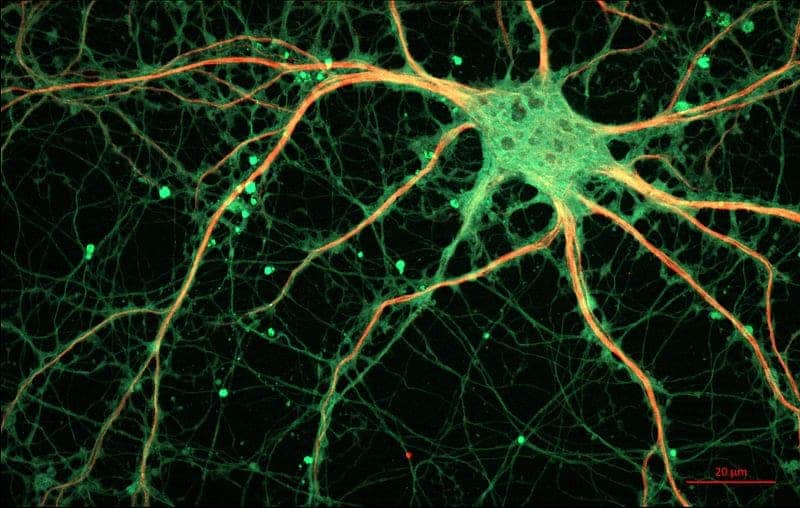It may sound like science fiction, but neuroscientists are currently able to manipulate the activity of specific neurons in the brain — with light alone.

Using certain wavelengths of light, researchers can turn neurons on and off at will, thanks to a technique called optogenetics. Even better — they’re already able to use this technique to manipulate memory in animals. Let’s dive into how this technique works and see how optogenetics is used to manipulate memory – and what it could mean for the rest of us.
What is Optogenetics?
Erasing memories with a flash of light à la Men in Black might not be that far off — and we have algae to thank for this.
It’s been known for quite a while that unicellular algae are able to control ion flow across their membrane by using light. That’s particularly relevant for neuronal activity, which is also determined by the flow of positive and negative charge. If the inside of the neuron becomes sufficiently positively charged, it “activates” the neuron. Conversely, if the inside is negatively charged, the neuron will be unable to activate. So by applying the algae’s technique, neurons are able to be switched on and off using nothing more than light.
However, the mechanism for this process wasn’t well understood until 2002, when researchers identified the key protein that makes this work: channelrhodopsin. When exposed to blue light, channelrhodopsin allows positive charge to enter the neuron, leading to the cell’s “activation”.
It only took three years for scientists at Stanford to successfully insert this newly-identified channel into neuronal cells and control their activity — so by 2005, the earliest form of optogenetics was already available. It’s stunning how quickly things have developed, but it just goes to show that scientific discoveries can have far-reaching, unpredictable consequences.
But this is only the beginning.
Getting these channels into animals is no easy feat because they need to be expressed in their DNA. This is done either by breeding animals that are engineered to express the protein or by introducing a virus that can change DNA in a region of interest — and this is where it gets really interesting.

Some viruses can change the DNA of cells they’re injected into. In this case, researchers inject the virus into their brain region of interest and, after 1-2 months, the protein will be fully expressed. The most amazing aspect of the technique is its simplicity. When it’s time to manipulate brain activity, researchers simply shine a laser light onto the area of the brain they want to manipulate. We can even do this in fully awake, functioning animals – the light itself doesn’t bother them in any way.
What can we use this for?
Since 2005, optogenetics has grown and developed, no longer being limited to rhodopsin channels — but the basic principles remain the same. Researchers have access to several photoactivatable proteins and channels, most of which have been developed form a variety of light-sensitive plants and bacteria.
For example, Dr. Klaus Hahn at UNC Chapel Hill developed a photoactivatable protein, called Rac1, that uses a light-sensitive protein domain found in a plant that keeps the protein non-functional until it is exposed to light. Dr. Haruo Kasai at the University of Tokyo took things one step further, modifying the protein so that it works in the brain.
Dr. Kasai and colleagues found that prolonged activation of the protein Rac1 shrinks synaptic spines — neuronal protrusions which help transmit electrical signals to the neuron’s cell body. It’s speculated that the formation or the enlargement of spines is essential for long-term memory storage.
In a groundbreaking Nature paper, Dr. Kasai modified this protein so it would only be expressed in spines that had recently created or modified in size — the idea was to target newly formed memories. Kasai’s team trained mice expressing this protein to improve performance on a task. After subsequently shining blue light onto their brains, the mice behaved as though they had never trained in the first place.
You might be wondering why we would even want to develop technology that erases memory. Well, one potential application is to erase “bad” memories — such as trauma experienced in patients with PTSD. Work on this has already started.
[panel style=”panel-success” title=”Fear conditioning” footer=””]In rodents, fear is tested using a technique called fear conditioning. Typically, this is done by making the rodent associate an unpleasant event, a foot shock, with a particular cue, such as a tone. However, in work done by Dr. Roberto Malinow at UC San Diego, they skipped the “middleman” and instead stimulated a pathway from the auditory cortex (used for processing sounds) to the amygdala (used to create a fear memory) using channelrhodopsin to “mimic” a tone-shock pairing. After showing the rats had developed fear, the researchers used a process called long-term depression to weaken this connection and found that when they tested animals again, they behaved like they had never learned the fear in the first place.
[/panel]
A reminder
Of course, it makes much more sense to think about the opposite — bringing back lost memories. Here, optogenetics shines once again.
Just last year, Dr. Christine Denny and her team at Columbia University demonstrated that they could bring back memories in a mouse model suffering from Alzheimer’s disease. They were able to do this by using mice that, through genetic programming, are able to permanently “tag” neurons under certain conditions. Some researchers believe that the network of neurons connected with one another are what actually stores long-term memories — and activating all of these neurons at the same time was able to “remind” the mice of that memory. In other words, optogenetics can “tag” this group of neurons, activating it later to reinstate those connections and return the memory.

To sum things up, scientists are using the new tool of optogenetics, and it’s impressive how far they’ve been able to come in such a short time. Optogenetics is making great strides in the field of memory research, and it shows a great deal of potential. Although the creation and destruction of memories may sound dangerous, it also has great therapeutic potential for a wide variety of neuropsychiatric diseases. Who knows — perhaps one day we’ll just go to the doctor to receive our “laser treatments” to combat the memory loss associated with old age.
Articles:
Wu, Y. I., et al. (2009). “A genetically encoded photoactivatable Rac controls the motility of living cells.” Nature 461(7260): 104-108.
Hayashi-Takagi, A., et al. (2015). “Labelling and optical erasure of synaptic memory traces in the motor cortex.” Nature 525(7569): 333-338.
Nabavi, S., et al. (2014). “Engineering a memory with LTD and LTP.” Nature 511(7509): 348-352.
Perusini, J. N., et al. (2017). “Optogenetic stimulation of dentate gyrus engrams restores memory in Alzheimer’s disease mice.” Hippocampus 27(10): 1110-1122.


